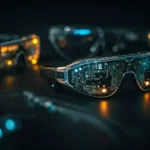Future Beyond Smartphones
The transition from smartphones to 100% smart glasses is a compelling vision, and many tech leaders believe it’s not a matter of “if,” but “when.” The future beyond smartphones is a reality, not just a dream. Here’s how this transition is likely to unfold, along with the benefits and challenges:
The Vision of 100% Smart Glasses Replacing Smartphones
The core idea is to move from a “heads-down” experience with a phone to a “heads-up, hands-free” interaction with digital information seamlessly integrated into the real world. Imagine:
- Information overlaid on reality: Directions appearing on the street, nutritional info on food items, or details about landmarks as you look at them.
- Intuitive interaction: Voice commands, gestures, and eye-tracking replacing tapping and swiping.
- Always-on assistance: An AI assistant that sees what you see and understands your context, providing proactive help.
- Ultimate portability: All your computing power and connectivity within a lightweight, stylish pair of glasses.
- Seamless communication: Calls, messages, and video chats experienced more naturally, as if the person is in the room with you or a floating avatar.
- Enhanced productivity: Accessing schematics, instructions, or data hands-free in professional settings.
- Immersive entertainment: Virtual screens of any size for movies, games, and other media, wherever you are.
How the Transition Might Happen – Smart Glasses Evolution
The future beyond smartphones – it’s unlikely to be a sudden switch, but rather a gradual evolution:
- Complementary Devices: Initially, smart glasses will likely function as extensions of smartphones, offloading certain tasks and providing unique AR experiences. This is already happening with devices like Ray-Ban Meta glasses, which can take photos/videos, play audio, and connect to AI assistants.
- Increasing Independence: As smart glasses become more powerful, miniaturized, and self-sufficient, they will reduce their reliance on a tethered smartphone for processing, data, and connectivity. Advancements in battery life, display technology, and onboard AI will be crucial here.
- Feature Parity (and Beyond): Smart glasses will gradually gain the capabilities of smartphones, including robust communication, comprehensive app ecosystems, and advanced photography. They will then leverage their unique form factor to offer experiences that smartphones cannot, such as true augmented reality and spatial computing.
- Shifting Habits: As the benefits of hands-free, heads-up computing become undeniable, user habits will naturally shift away from pulling out a phone for every digital interaction. Social acceptance will also play a huge role, moving smart glasses from “geeky gadget” to everyday essential.
- Specialized Use Cases Leading the Way: Industries like healthcare, manufacturing, and logistics are already seeing the immediate benefits of hands-free information access and remote assistance through smart glasses, accelerating their development and adoption.
Key Benefits of 100% Smart Glasses
The smart glasses evolution will change how we do many things:
- Hands-Free Interaction: The most significant advantage, allowing users to stay engaged with the real world while accessing digital information.
- Enhanced Contextual Information: AI-powered glasses can provide relevant data based on what you’re seeing, leading to a more intuitive and helpful experience.
- Reduced Screen Time (in a way): While still interacting with digital information, it’s integrated into your field of view rather than demanding constant attention on a separate screen.
- Improved Multitasking: Perform digital tasks while simultaneously engaging in physical activities.
- More Natural Communication: Voice-based interactions and seamless audio integration.
- Ultimate Portability and Accessibility: Always on, always with you, and always ready to provide information.
- Revolutionary AR Experiences: Immersive gaming, interactive learning, and new ways to explore the world.
Challenges to Overcome
Despite the immense potential, the smart glasses evolution has several hurdles that need to be cleared:
- Battery Life: Powering displays, cameras, sensors, and AI in a small form factor for all-day use remains a major technical challenge.
- Design and Aesthetics: Smart glasses need to be comfortable, lightweight, and stylish enough for widespread social acceptance. Early models have often been bulky or conspicuous.
- Privacy Concerns: Constant cameras and microphones raise significant ethical and legal questions about surveillance and data collection, both for the user and those around them.
- Display Quality and Field of View: Achieving high-resolution, bright displays with a wide field of view in varying light conditions is difficult.
- Processing Power and Miniaturization: Packing powerful processors and other components into a sleek frame without overheating is complex.
- Input Methods: While voice and gestures are promising, developing intuitive and reliable input methods that go beyond basic commands is crucial.
- Cost: Initial high prices will limit early adoption; mass-market affordability is key.
- Social Acceptance and Cultural Norms: People are accustomed to smartphones. Changing deeply ingrained habits and overcoming the “awkwardness” factor will take time.
- Developer Ecosystem: A robust ecosystem of apps and services specifically designed for smart glasses will be essential to drive adoption.
Timeline – The Future Beyond Smartphones
Some analysts predict that AI-powered smart glasses could begin to seriously challenge and potentially even replace smartphones by 2026, with widespread adoption by 2030. Companies like Meta, Apple, Snap, and Google are heavily investing in this space, indicating a strong belief in its future.
The transition to 100% smart glasses will be a monumental shift in how we interact with technology, moving it from a device in our hand to an omnipresent, intelligent layer on our reality. While challenges remain, the benefits of this hands-free, heads-up future are compelling enough to drive significant innovation and investment.
Additional helpful information
First, there needs to be a transition from smartwatches to smart glasses – Transition From Smartwatches to Smart Glasses




